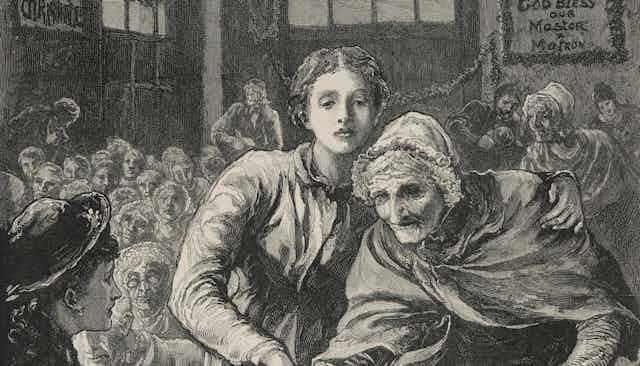In 1803, John Braithwaite was a very elderly man. A gentleman farmer, once influential in his community, he was now struggling with a deteriorating mind. According to his doctor, Braithwaite complained particularly “of an uneasiness and confusion in his head and giddiness and want of recollection”, and he often had “a vacant stare as if he did not immediately recollect” his friends.
One day, he went fishing with his companion at a nearby lake. After returning, he became extremely confused, and could not remember where he had left his horse. On another occasion, when playing cards, Braithwaite again became muddled and distressed. He “broke out into a most violent frenzy without any cause given and cursed…most violently and behaved in so frantic a manner” that his neighbour had to take him home.
Those who have cared for a loved one with dementia might find some of Braithwaite’s behaviour and emotions familiar. While the language of these sources is old-fashioned, and the scenarios so clearly from a different time, Braithwaite’s visceral distress and anger feel so recognisable.
Braithwaite would kill himself later in 1803. An inquest after his death found that he had said: “He thought it hard that the almighty [should] afflict him in that manner”. He had also told his surgeon that “death [would] be a blessing to him”.
When I began using 18th century coroners’ inquests to research the history of suicide, I did not expect to find so many stories like these. Stories of old men and women struggling with age-related problems, like frailty and mental decline. In fact, in 18th century England, it is thought that around 40% of suicides were in the over-50s age group, even though they represented less than 20% of the general population.
Growing old with limited support
Looking at 100 inquest hearings from archives in London, Kent, Cumbria, Essex, Suffolk and Bath, I built up a picture of suicide in the elderly during the Georgian period.
From the testimonies of friends, family and colleagues, what I found was that many were seriously concerned about loneliness, memory loss, financial vulnerability and becoming burdens upon those they loved. They also experienced a lot of sickness and pain at a time when medical care was limited at best.
Thomas Norman, an older gentleman who killed himself in 1771, was “upon every (new) illness…effected by a great dejection of spirits”, as if each new bout of sickness represented another aspect of his inevitable decline. Illness and infirmity were not, however, just experienced in the body. They were experienced socially, and within a society that offered fairly limited care for its elderly members.

A major concern for the elderly was that infirmity would prevent them from working. Parishes (the smallest unit of local government) provided some security in the form of outdoor-relief, which was the provision of food, money and clothing for people living in the community.
Alternately, parishes took the elderly into workhouses. These were institutions that housed the destitute in return for their labour. But these options often represented a decline in living standards and independence.
Cuthbert Cousins, who died in 1772, was “about 60 years of age and infirm, and unable to work and maintain himself as he had done”. As Cousins lay dying, those around him wanted to know why he had attempted suicide. He simply replied that “being an old man and out of work, he did it for want”. In other words, he did it because his final words were an unequivocal statement about this relationship between old age, unemployment and poverty.
Being a burden
There’s sometimes this idea that in the “olden days”, the elderly were better looked after by their families. But while some people were cared for by children and other family members, many also struggled to take care of their older relatives and elders experienced feelings of abandonment and loss.
Sarah Fenwick had previously been living with her adult daughter, but she “several times told her mother that her family was large” and eventually “perswaded [sic] her to go into the workhouse”. Like many other elders, Fenwick hated being in the workhouse and wanted to live with her family. Of course, workhouses no longer exist, but fears about being neglected or cut off from one’s family are familiar to some older people today.
It is also common for old people to worry about being a burden to those around them. Again, my sources revealed a long history of such concerns.
William Richmond, an “old carpenter”, was particularly anxious about “encumbering” his children. When his landlord’s wife “advised him to apply to his son” for help, he simply “said he hoped he should be better and should wish not to trouble his son”. In an age long before universal pensions, being forced to rely on family could be distressing for once self-reliant people.
Research has argued that throughout the 18th century, suicide was reinterpreted as an act driven by medically-rooted “insanity”. But many old people who ended their lives did not feel that they were so-called “lunatics”.
Many understood their actions as a rational response to the prospect of ageing grimly in the society in which they lived. For some, like Braithwaite, memory loss and frailty were at the root of their distress. What he experienced would now clearly be diagnosed as dementia but in the 1700s there was little understanding of the condition and, as a result, little support.
For others, age was made unbearable because societal failures threatened their social and financial security. Standards of living dropped along with independence and the only options for survival were either the workhouse or to depend upon family members – adding to their financial concerns and feeling like a burden upon them.
This reminded me of the poor provision of social care we sometimes see today and the financial stresses of looking after elderly family members. It also, perhaps, holds lessons for how we should treat the elderly in our society.

